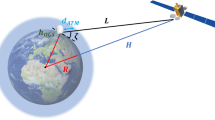Abstract
Intersatellite optical wireless communication (IsOWC) system has garnered global attention for facilitating high-speed data transfer between two space-based satellites. However, accurately predicting received or output signal power in a lower earth orbit trajectory is challenging due to factors such as background light, scintillation, pointing error, and optical crosstalk. To overcome this problem, a technique based on artificial neural networks (ANN) is proposed to enhance the efficiency of received signal power in the IsOWC system. The input features for an IsOWC system include propagation distance, scintillation attenuation, wavelength, pointing error, and input power, ranging from 1 to 25 km, 0 to 6 dB, 800 to 1600 nm, 0 to 1 µradian, and 0 to 4.77 dBm, respectively. The output feature i.e., received signal power, ranges from − 100 to 34.99 dBm. Before training, exploratory data analysis is performed on 2100 datasets generated by 16-quadrature amplitude modulation based IsOWC system. Furthermore, an ANN model is trained, resulting in a low mean squared error (MSE) of 4.8 × 10− 6 compared to other machine learning model. The impact of hyperparameter tuning on the MSE curve is rigorously discussed. Additionally, the scatter plot between true power and ANN power prediction, along with an error density plot analysis are thoroughly explored. The proposed technique is intended to efficiently predict the received signal power and find applications in terrestrial communication, military operations, 5G beyond communication, underwater communication, and more for global internet connectivity.








Similar content being viewed by others
Data Availability
Data underlying the results presented in this paper are not publicly available at this time but may be obtained from the authors upon reasonable request.
References
Arora H, Goyal R (2017) A review on inter-satellite link in inter-satellite optical Wireless Communication. J Opt Commun 38(1):63–67
Kaushal H, Kaddoum G (2016) Optical Communication in Space: challenges and Mitigation techniques. IEEE Commun Surv Tutorials 19(1):57–96
Mansour A, Mesleh R, Abaza M (2016) New challenges in wireless and free space optical communications. Opt Lasers Engg 89:95–108
Patnaik B, Sahu PK (2012) Inter-satellite optical wireless communication system design and simulation. IET Commun 6(16):2561–2567
Rameshchandra K, Pathi AMV, Satyanarayana NV, Budumuru PR (2021) Received Signal Strength (RSS) based channel modelling, localization and tracking Conference: 2nd International Conference on Advances in Computing, Communication, Embedded and Secure Systems (ACCESS), Ernakulam, India
Ho TH, Trisno S, Smolyaninov II, Milner SD, Davis CC (2004) Studies of pointing, acquisition, and tracking of agile optical wireless transceivers for free-space optical communication networks. Opt Atmos Propag Adapt Syst VI 5237(147):147–158
Devarajan D, Pillai SS (2014) Optimization of Laser Satellite Communication System through Link Budget Prediction. Conference: International Conference on Information Communication and Embedded Systems (IEEE), Chennai, India
Famoriji JO, Adedayo OO, Ale DT (2015) An Improved Transmission equation under environmental influences. Int J Sci Eng Investig 4(41):20–24
Arnon S, Sadot D, Kopeika NS (1994) Simple mathematical models for temporal, spatial, angular, and attenuation characteristics of light propagating through the atmosphere for space optical communication: Monte Carlo simulations. J Mod Opt 41(10):1955–1972
Nadir Z, Bait-Suwailam M, Idrees M (2016) Pathloss measurements and prediction using statistical models. Conference: MATEC Web Conf. Muscat, Oman
Epple B (2010) Simplified channel model for simulation of free-space optical communications. J Opt Commun Netw 2(5):293–304
Yeo JY, Lee YH, Ong JT (2014) Rain attenuation prediction model for satellite communications in tropical regions. IEEE Trans Antennas Propag 62(11):5775–5781
Lionis A, Peppas K, Nistazakis HE, Tsigopoulos A, Cohn K, Zagouras A (2021) Using machine learning algorithms for accurate received optical power prediction of an FSO link over a maritime environment. Photonics 8(6):212
Karra D, Goudos SK, Tsoulos GV, Athanasiadou G (2019) Prediction of received signal power in mobile communications using different machine learning algorithms:A comparative study. Conference: 5th Panhellenic Conf. Electron. Telecommun. Volos, Greece
Giuliano R, Innocenti E (2023) Machine learning techniques for non-terrestrial networks. Electronics 12(3):652
Igwe KC, Oyedum OD, Aibinu AM, Ajewole MO, Moses AS (2021) Application of artificial neural network modeling techniques to signal strength computation. Heliyon 7(3):06047
Bai L, Wang CX, Xu Q, Ventouras S, Goussetis G (2019) Prediction of channel excess attenuation for satellite communication systems at Q-band using Artificial neural network, IEEE antennas Wirel. Propag Lett 18(11):2235–2239
Author information
Authors and Affiliations
Contributions
Subhash Suman contributed to Writing-Original Draft, Methodology, and Conceptualization; Ayush Kumar Singh contributed to Data curation and Formal analysis; Prakash Pareek contributed to Visualization and Writing-review; Jitendra K. Mishra contributed to Supervision, Validation, Writing-review and Editing.
Corresponding author
Ethics declarations
Competing Interests
The authors declare no competing interests.
Conflict of Interest
There are no declared conflicts of interest or competing interests that relate to the article’s content.
Additional information
Publisher’s Note
Springer Nature remains neutral with regard to jurisdictional claims in published maps and institutional affiliations.
Rights and permissions
Springer Nature or its licensor (e.g. a society or other partner) holds exclusive rights to this article under a publishing agreement with the author(s) or other rightsholder(s); author self-archiving of the accepted manuscript version of this article is solely governed by the terms of such publishing agreement and applicable law.
About this article
Cite this article
Suman, S., Singh, A., Pareek, P. et al. Efficient Power Prediction for Intersatellite Optical Wireless Communication System Using Artificial Neural Network. Mobile Netw Appl (2024). https://doi.org/10.1007/s11036-024-02308-w
Accepted:
Published:
DOI: https://doi.org/10.1007/s11036-024-02308-w




